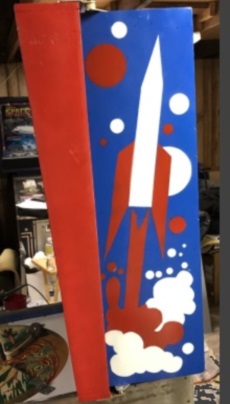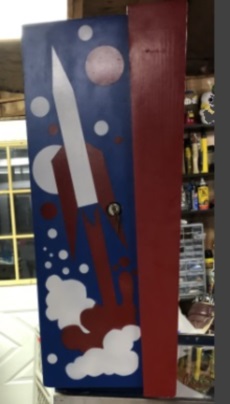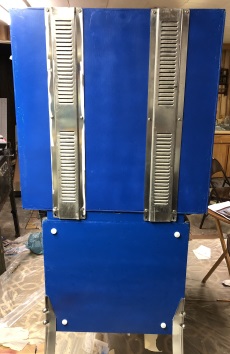Cabinet
The cabinet had a simple design, but ended up taking me longer to repaint than any other game I have restored. It turned out to be a L-O-N-G tedious process. Using the process explained elsewhere in this website I created stencils for each color, stripped and repaired the cabinet, and then repainted it. To create the stencils, I make a drawing of each color and side on tracing paper and then transfer this to acetate sheets. The difficulty with this cabinet was that it had dozens of circles, 135 to be exact. In making my own stencils, I can't make perfect circles. So, I had to buy circle stencils at Hobby Lobby. You can see a picture of them on this page. The problem is that while these stencils have several sized circles on them, you can only use one at a time. I had four stencils, so that meant that at best I could only paint four of the circles at a time, and that was assuming that I could find four of the same color and spread far enough apart that I could actually use all four stencils at once. Then, once I painted them, I had to wait for the paint to dry well enough before I could re-use the stencil. Couple with this the fact that at each interval I had to reposition the stencils to the right place, cover up all of the other areas that aren't getting painted, and it made it take forever to finally get the cabinet repainted on all sides. Here's a break down of the total number of circles.
| Cabinet Section | White Circles | Red Circles | Total Circles Per Section |
|---|---|---|---|
| Main Cabinet Left | |||
| Main Cabinet Right | |||
| Head Left | |||
| Head Right | |||
| Main Cabinet Front | |||
| Cabinet Totals |
So, even doing four at a time (which I wasn't always able to do), it would take a minimum of 34 different "set-ups." In reality, it took about 60 set ups due to only be able to do one or two at a time on the head and front and not always getting to do four on the cabinet sides. This was in addition to the set-ups for the rocket and cloud stencils.
After creating the stencils, I removed the legs, door, and any hardware from the cabinet that will get in the way of the repaint. Next, I stripped the cabinet using Citrus strip. I then repaired the dings and gouges using Bondo and wood filler. I use wood filler for most normal dings and Bondo for larger areas that need repair with added strength. I then sand all sides with 150, then 220, then 330 grit sandpaper. Next, I wipe the sides down with mineral spirits to remove any residue. Then I tape off the side rails and any other areas that I do not want to get paint on. On this cabinet I used Krylon brand spray paints. I have found them to be the best overall for the price. You can re-spray at any time and the paint won’t lift. It also dries very fast (usually within 12-15 minutes). The base coat on this game was blue with white and red-orange as the applied colors. Note that my red-orange ended up closer to red. I think the lighting in the store made it look less red than it turned out. It still looks good but is not quite as "orangy" as the orininal.
On some games, it matters which order you apply the colors. On this game, I did the cabinet in sections and based on what I thought was easiest, I did that color first. As for the circles, I did them based on my ability to use as many stencils at once as possible. I used the original tracing of the artwork (on tracing paper) to help me position the circle stencils and then secured them and covered the rest of the areas. Again, this was a time-consuming process as it was the only way I knew to get the circles to look right.
I also installed brand new legs. The legs I had were in really rough shape and instead of spending a lot of time de-rusting them, polishing and painting them like I have on other games, I decided to just get new legs from Steve Young's Pinball Resource.
Miscellaneous
Besides what I explained above, I did the following to this game:
- Tumbled all playfield metal parts
- Cleaned the ball rail and under the apron parts
- Derusted the internal cabinet hardware and lock mechanism
- Polished the playfield holders and ball-roll tilt
- Polished the rear vents on the back of the machine
- Installed a new heavy duty three-pronged cord
- Installed brand new legs
- Installed new reproduction bumper cap, body, and skirt
- Installed new reproduction drop targets for the yellow drop targets. The others were in good condition.
- Installed new rubbers and new ball
- Polished all of the large metal areas with Never Dull and/or Meguiar's
- Attached a new Gottlieb sticker on the coin door
- Installed new leg levelers
- Vacuumed the inside cabinet
- Cleaned all the plastic parts



